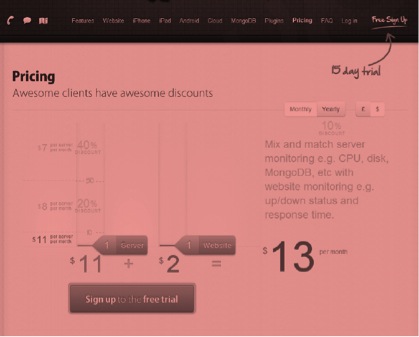The trend of pure-play SaaS providers and on-premise software ISVs diversifying into SaaS is on the rise. SaaS revenue for global top 10 ISVs forms 40% of all software revenues. According to Gartner, the SaaS revenues will grow annually at 17.5% to form 24% of all software revenues in 2016. This would amount to USD 22.5 billion up from USD 14.5 billion in 2012. While SaaS makes a perfect business sense in the long term, in the short term, SaaS providers face unprofitable business for two or more years among other challenges in marketing and product management. SaaS has given birth to new ways of pricing like fixed-fee or usage based pricing, pay-as-you-go, freemium model and so on. Pricing is an important aspect of SaaS business.
I will be covering SaaS pricing through a series of blogs on topics like concept of value pricing, role of segmentation and tiers, pricing structure, metrics, managing pricing over product life cycle, competition and product positioning. I start with concepts of value and role of segmentation.
A Google search throws up ‘n’ number of SaaS pricing models. But success of any pricing model is always rooted in a sound value proposition of the offering. Cost plus pricing is common, seems financially prudent thing to do but is known to leave a lot of money on the table. Also remember, even when offered free the customers would not pick up your offering if they do not perceive value in it. The first step in pricing strategy is to ascertain value of your offering.
Demonstrate value of your offering
The economic and emotional values are the primary drivers of purchase decision. The economic value of your offering is has two components – price of the next best alternative and the value of what differentiates your offering from the next best. You have no control on the competitors’ price. Therefore differentiation is the way to go to provide better overall customer value and better price. Sometimes customers may not perceive the value. It is critical your marketing communication ensure what is important to customer, specially differentiated features and benefits come to the buyers’ notice. So develop your value proposition and communicate it clearly to the customers.
A simple equation for the value proposition is (Value = Benefits – Costs). For this, you must quantify the economic value of your products features together with the emotional and psychological value. One way to do this is to quantify impact of your offering on customers’ revenue, productivity, profitability and so on. Here is an example of computing economic value of a feature.
A midsize software product MNC in India was considering moving to Google Apps. Google Apps offer benefits to two entities in an organization – IT and end-user. The IT benefits include cost savings on licenses, IT infrastructure and operations and maintenance. The end user benefits include – 1) productivity gain due to improved email search, spam filtering, archiving and improved response times, 2) quicker issue resolution and decision making thru shared editing of documents and 3) improved response time to customers and partners. Let us see how we can calculate productivity gain from just one benefit, say, and faster email search. Assume –300 employees, 5 day workweek, 50 work weeks, average per hour employee cost of $10, average 1 hour email usage per day, and a 10% saving (estimate based on previous implementations). This translates into an annual productivity gain worth 300 x 1 x 5 x 50 x 0.1 x $10 = $75 K. The total benefits (productivity gains + IT cost savings) for three years operations worked out at $81K, $111K and $123K. Total subscription costs in this period were $18,900 (300 x $63 per user) per year. There were initial costs for transitioning from legacy system, testing, pilot and training amounting to $5K. The overall risk adjusted net present value of benefits (including several other benefits like archiving, SPAM filtering, threading, IM etc.) was $205K. The customer went ahead with the purchase.
Segment your customers
All customers do not have same needs, value perceptions and the willingness to pay. Targeting the whole population with one product and one price is not the way t best financial performance. It leads to leaving money on the table for some customers who are willing to pay higher and losing out another set of customers who can’t afford the price. Thankfully, the customers can be sub grouped or segmented based on certain similarities. Value based segmentation helps create pricing commensurate with the perceived value by those customer segments.
Segmentation requires creativity in addition to analysis. It must reflect your marketing strategy. For example, Zoho, Google Apps and Microsoft Office 365, compete in online document management area (word processor, spread sheet, presentations, email). However, Zoho Docs views the market in three segments represented by personal, standard and premium licenses priced at $0, $3 and $5 per month per user. Office 365 has more complex view of the same market. It segments it into seven segments, namely small, midsize and enterprise business, education, government, professional and home with fourteen different licenses ($0 to $20 per month per user)! In contrast, Google Apps has just one offering at $5 per month per user. So, why does Microsoft has seven segments and fourteen price points? A closer study would reveal that the breadth and depth of features / functionality offered by Office 365 far outstrips Zoho docs and Google apps. It allows creation of diverse bundles of features and pitch them to different segments at price points that meet respective value perceptions. By doing this Microsoft is able to capture the students segments (low paying capacity) while maintaining premium pricing for the enterprise. Microsoft would lose both lot of money and a large chunk of market if they decided on just one segment with one price. Interestingly, it is possible to create segmentation and variable pricing without bundling different sets of features i.e., on an identical offering. For example, railways transports grains at much cheaper rates compared to manufactured consumer goods in the same wagon. There is very little difference in the inputs that go into transporting the two items. I have yet to see this in software or SaaS.
One more point in favour of segmentation is as follows. In a high fixed cost industry like software and SaaS, it is a good strategy to capture the large volume of customers in the long tail with a price that is just equal to the offering’s variable cost. This is good for revenue. Generally, more segments the better. The factors that limit number of segments are complexity and sales administration cost, smaller differentiation between the offering for adjacent segments and customer propensity to select the lower priced segment when differentiation is small.
I will close this blog with a quiz. Given below is the old pricing page of Serverdensity (http://www.serverdensity.com). Serverdensity is a provider of cloud based server monitoring. They have tiered pricing based on number of servers that a customer has. What is good, bad and ugly about this pricing?
Please look for the next blog on SaaS pricing metrics.



